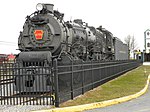Pennsylvania Railroad class H6

The Pennsylvania Railroad's class H6, H6a, and H6b steam locomotives were of the 2-8-0 "Consolidation" freight type, the most numerous class on the railroad with 1,707 units and the second most prolific 2-8-0 class in North America, with the USATC S160 class rostering 88 units more. The three subclasses differed as follows: In the 1920s, 699 H6a and H6b had superheaters added, and cylinder size increased from 22 in (560 mm) to 23 in (580 mm). These rebuilt units were reclassified to H6sa and H6sb. Class H6 were used throughout the system as mainline freight haulers, on local freights, and as switchers in yards. They were frequently seen double- and tripleheading long freight trains up the steep grades on the Pennsy.During the period when the PRR was building the H-6 class, the railroad had effective stock control of the Baltimore and Ohio Railroad, and installed a PRR vice-president Leonor F. Loree, as president of the B&O. Subsequently, the B&O bought a large group of identical locomotives from the American Locomotive Company; these were initially classified class I-4, later becoming class E-24. The E-24 class had many variations, some being converted to switchers, or receiving superheaters and new valve chests. The E-24a was equivalent to the PRR H-6sb. None of the B&O E-24 class survived to the diesel era.
Excerpt from the Wikipedia article Pennsylvania Railroad class H6 (License: CC BY-SA 3.0, Authors, Images).Pennsylvania Railroad class H6
Gap Road, Strasburg Township
Geographical coordinates (GPS) Address Phone number Website Nearby Places Show on map
Geographical coordinates (GPS)
| Latitude | Longitude |
|---|---|
| N 39.982222222222 ° | E -76.161111111111 ° |
Address
Railroad Museum of Pennsylvania
Gap Road 300
17579 Strasburg Township
Pennsylvania, United States
Open on Google Maps









